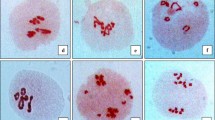Summary
-
1.
In the progeny of radiation-induced diploid X1-variants of)enothera bertetiana, trisomic mutants were found quite frequently. The object of the described investigations was to elucidate the cause of this phenomenon.
-
2.
In these X1-variants, deviating diakinesis configurations attributable to radiation-induced translocations were observed frequently. For example, instead of the normal 14-chromosome ring, 2 rings were often found, both rings being even-numbered or both odd-numbered.
-
3.
The X1-mutants with odd-numbered diakinesis rings are chiefly responsible for the segregation of trisomic plants in the X2. For in this instance, as a consequence of quite normal chromosome distribution in the anaphase, a quarter of all gones receive n+1 chromosomes. After combination with normal n-pollen, 2n+1 plants are obtained. Thus in this case trisomic plants are formed without usual spontaneous non-disjunction.
-
4.
To a lesser degree, plants with deviating chromosome numbers were also found in the progeny of X1-mutants which had even-numbered diakinesis rings. The occurence of such plants is attributable to non-disjunction, which is evidently furthered by radiation-damaged chromosomes.
Similar content being viewed by others
Literatur
Arnold, C. G.: Genetische und zytologische Untersuchungen an trisomen Mutanten derOenothera berteriana. Z. indukt. Abstamm.-u. Vererb.-L.86, 622–662 (1955).
—: Untersuchungen zur Pollenfertilität trisomer Oenotheren. Z. Vererbungsl.89, 161–169 (1958a).
—: Selektive Befruchtung. Ergebn. Biol.20, 67–96 (1958b).
—: Untersuchungen an Röntgenmutanten derOenothera berteriana. I. Über gehäufte, durch Trisomie induzierte Translokationen. Z. Vererbungsl.93, 417–434 (1962).
—: Untersuchungen an Röntgenmutanten derOenothera berteriana. II. Über die Ursachen der F1-Abweichungen nach Röntgenbestrahlung. Biol. Zbl.82, 185–207 (1963).
—, u.H. Bina: Über 15chromosomige Mutanten derOenothera odorata. Flora (Jena)144, 537–561 (1957).
Buchner, E.: Genetische und zytologische Untersuchungen an trisomen Mutanten derOenothera odorata. I. Flora (Jena)143, 543–574 (1956).
Catcheside, D. G.: Origin, nature and breeding behaviour ofOenothera Lamarckiana trisomics. J. Genet.33, 1–23 (1936).
—: Non-disjunction in anOenothera interchange heterozygote. Heredity18, 63–75 (1963).
Cleland, R. E., u.F. Oehlkers: Erblichkeit und Zytologie verschiedener Oenotheren und ihrer Kreuzungen. Jb. wiss. Bot.73, 1–124 (1930).
Dittmann, Ch.: Genetische und zytologische Untersuchungen an trisomen Mutanten derOenothera odorata. II. Flora (Jena)143, 575–602 (1956).
Emerson, St.: The trisomic derivatives ofOenothera Lamarckiana. Genetics21, 200–224 (1936).
Ford, C. E.: Non-disjunction inOenothera and the genesis of trisomics. J. Genet.33, 274–303 (1936).
Hakansson, A.: Zur Zytologie trisomischer Mutanten ausOenothera Lamarckiana. Hereditas (Lund)14, 1–32 (1930).
Haustein, E.: Die Endenbezifferung einiger Oenotheren aus dem SubgenusRaimannia. Z. indukt. Abstamm.-u. Vererb.-L.84, 417–453 (1952).
—: Zur Cytologie einiger aus derOenothera odorata abgeleiteter Trisomen. Flora (Jena)143, 385–394 (1956).
Herzog, G.: Genetische und cytologische Untersuchungen über 15chromosomige Mutanten vonOenothera biennis undOenothera Lamarckiana. Flora (Jena)134, 377–432 (1940).
Michaelis, P.: Über experimentelle Erzeugung heteroploider Pflanzen beiEpilobium undOenothera. Biol. Zbl.48, 370–374 (1928).
—: Über experimentell erzeugte heteroploide Pflanzen vonOenothera Hookeri. Z. Bot.23, 288–308 (1930).
Oehlkers, F.: Meiosis und crossing over. Zytogenetische Untersuchungen an Oenotheren. Z. indukt. Abstamm.-u. Vererb.-L.78, 157–186 (1940).
Overeem, C. van: Über Formen mit abweichenden Chromosomenzahlen beiOenothera. I. Beih. bot. Zbl.38, 73–113 (1921).
—: Über Formen mit abweichenden Chromosomenzahlen beiOenothera. II. Beih. bot. Zbl.39, 1–80 (1923).
Renner, O.: Zur Kenntnis der 1tchromosomigen Mutanten vonOenothera Lamarckiana. Flora (Jena)134, 257–310 (1940).
—: Kurze Mitteilungen überOenothera. VI. Über die 15chromosomigen Mutantendependens, incana, scintillans, glossa, tripus. Flora (Jena)137, 216–229 (1943).
—: Die 15chromosomigen Mutanten derOenothera Lamarckiana und ihrer Verwandten. Z. indukt. Abstamm.-Vererb.-L.83, 1–25 (1949).
Rudloff, C. R., u.M. Schmidt: Untersuchungen über den Einfluß ungünstiger Witterungsverhältnisse auf die Reduktionsteilung und Embryosackbildung bei verschiedenen Oenotheren. Planta (Berl.)18, 104–167 (1932).
Schlösser, A.: Zur Frage der Genomstabilisierung bei Heteroploiden. Biol. Zbl.54, 436–445 (1934).
Schütz, G.: Genetische und zytologische Untersuchungen anEu-Oenotheren. Z. Bot.33, 481–525 (1939).
Schwemmle, J.: Genetische und zytologische Untersuchungen anEu-Oenotheren. Z. indukt. Abstamm.-u. Vererb.-L.75, 358–800 (1938).
—: Gibt es eine selektive Befruchtung? Biol. Zbl.68, 195–231 (1949).
—: Gibt es eine selektive Befruchtung? II. Biol. Zbl.70, 193–252 (1951).
—: Gibt es eine selektive Befruchtung? III. Biol. Zbl.71, 152–183 (1952).
—: Trisome Mutanten derOenothera odorata. Flora (Jena)143, 356–384 (1956).
Stubbe, H.: Studien über heteroploide Formen vonAntirrhinum majus L. I. Planta (Berl.)22, 152–170 (1934).
Vasek, F. C.: Induced aneuploidy inClarkia unguiculata (Onagraceae). Amer. J. Bot.43, 366–371 (1956).
Author information
Authors and Affiliations
Additional information
Mit 3 Textabbildungen
Rights and permissions
About this article
Cite this article
Arnold, CG., Kressel, M. Über das Gehäufte Auftreten trisomer Pflanzen in der Nachkommenschaft diploider Röntgenmutanten beiOenothera Berteriana . Zeitschrift für Vererbungslehre 96, 83–92 (1965). https://doi.org/10.1007/BF00888780
Received:
Issue Date:
DOI: https://doi.org/10.1007/BF00888780




